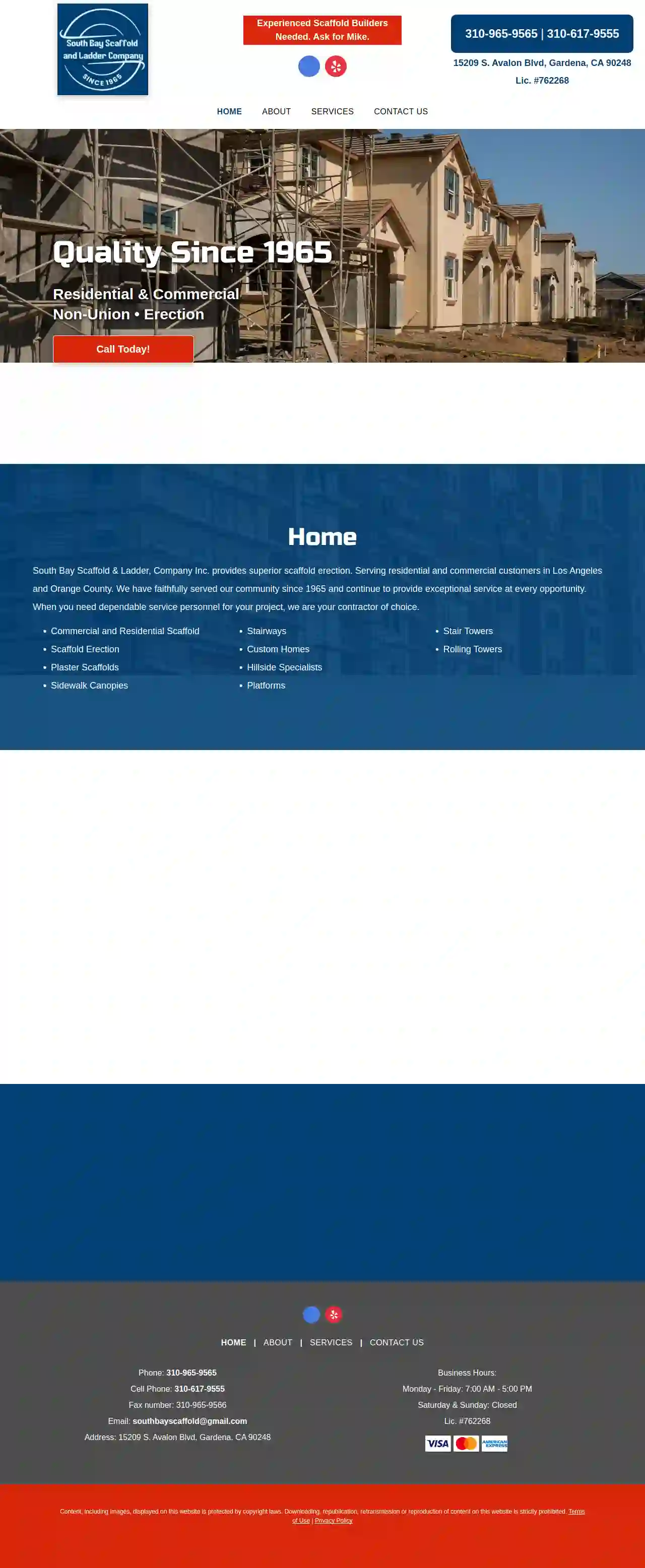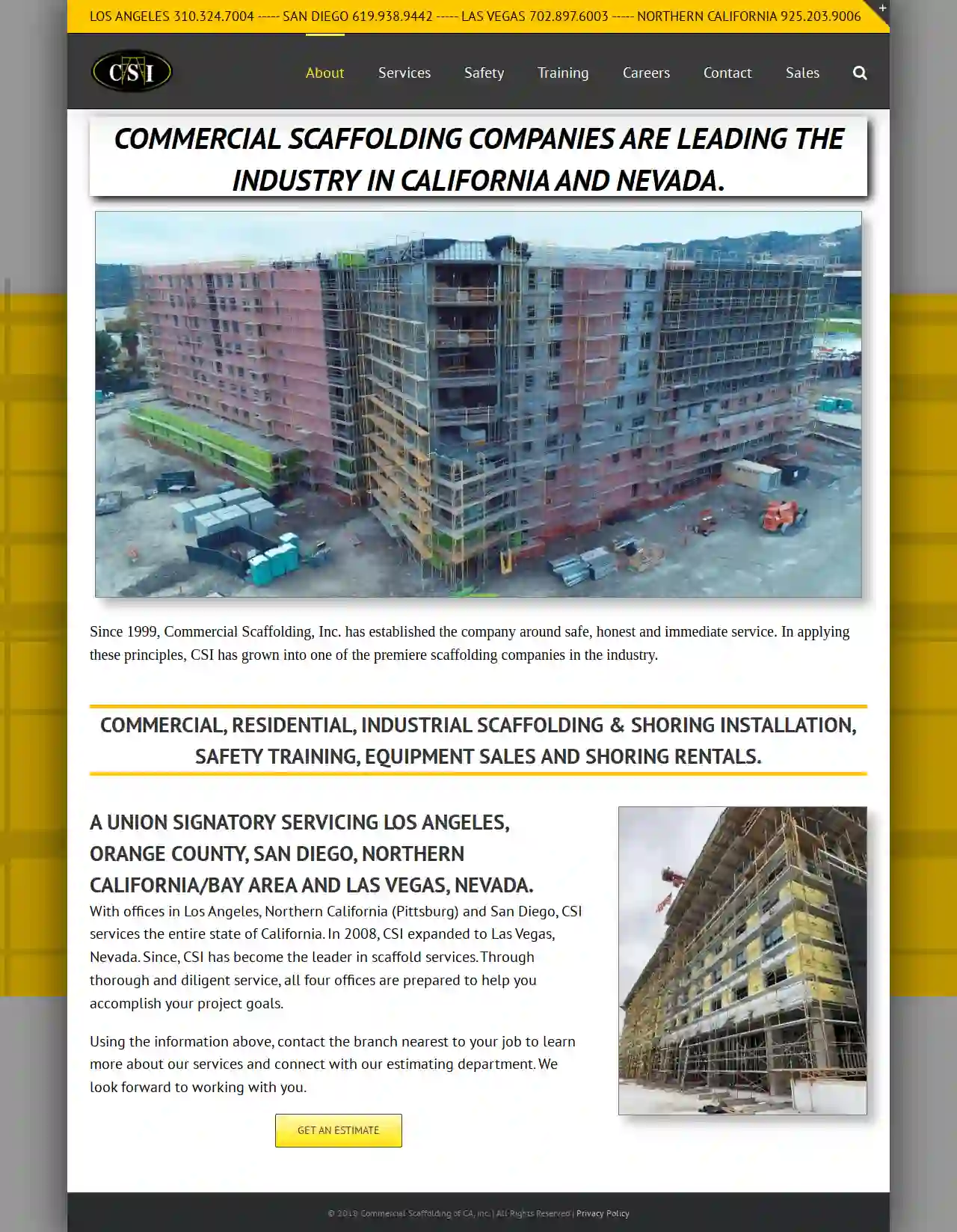Scaffolding Companies Los Altos
Find the best Scaffolding Experts in Los Altos
Get 3 FREE Scaffolding Contractors quotes for your project today! Compare profiles, reviews, accreditations, portfolio, etc... and choose the best deal.

Designs plastering inc
41 reviewsOxnard, USDesigns Plastering, Inc. Agustin Espinoza, the owner of Designs Plastering, Inc., provides reliable, cost-effective, high-quality plastering and lathing services. Designs Plastering, Inc. serves the general public, working on both residential and commercial projects. The company is known for its courteous, professional, and punctual service. They are adept at handling smaller domestic jobs with the same expertise as larger contracts. Their reputation is built on quality. Based in Oxnard, CA, Designs Plastering, Inc. covers Santa Barbara, Ventura, and parts of Los Angeles counties and surrounding cities. For a free, no-obligation estimate or quotation, you can contact us HERE . Alternatively, call the office at: (805) 469-8395 for a quick response. Mission Statement At Designs Plastering, Inc., our mission is to deliver the highest quality finishing work for your exterior or plastering project. We utilize the latest tools and techniques available and employ only qualified personnel. Our work, as well as our workers, are fully insured. Our presence on your job site is professional, efficient, and easily coordinated with other trades.
- Services
- Why Us?
- Accreditations
- Our Team
- Gallery
Get Quote
South Bay Scaffold & Ladder
3.54 reviews15209 S. Avalon Blvd, Gardena, 90248, USAt South Bay Scaffold & Ladder, Company Inc., we've been providing superior scaffold erection services to residential and commercial customers in Los Angeles and Orange County since 1965. Our team of experts is dedicated to delivering exceptional service at every opportunity. Whether you need dependable service personnel for your project, we're your contractor of choice. Our services include commercial and residential scaffold erection, plaster scaffolds, sidewalk canopies, stairways, custom homes, hillside specialists, platforms, and stair towers. Rolling towers are also available. We're conveniently located at 15209 S. Avalon Blvd in Gardena, just five blocks East of the 110 Freeway. Call us today at 310-965-9565 to discuss your scaffolding needs.
- Services
- Why Us?
- Accreditations
- Our Team
- Gallery
Get Quote
Power Scaffold Service
4.52 reviews157 East Terrance Way, Bakersfield, 93307, USAt Power Scaffold Services, we build long-lasting relationships with our clients by working closely with them to understand and anticipate their needs. We provide cost-effective solutions that enable our clients to complete their projects safely, on-time, and according to plan. Our top-notch, versatile team has erected and dismantled scaffolds for hospitals, theaters, restaurants, oil refineries, power plants, chemical plants, cement plants, and water treatment plants using our state of the art, long-lasting, and durable Cup-Lock Scaffold System.
- Services
- Why Us?
- Accreditations
- Gallery
Get Quote
Scaffolding San Francisco
51 reviews123 Scaffolding St, San Francisco, CA, 94103, USThe leading Bay Area supplier of the highest quality scaffold. We offer a complete range of services, from rental and sales to erecting & dismantling. Our team is committed to safety, reliability, and resourcefulness, ensuring customer satisfaction and adhering to OSHA standards.
- Services
- Why Us?
- Accreditations
- Our Team
- Testimonials
- Gallery
Get Quote
J1 Scaffolding
Higuera Road, San Jose, California, 95148, USJ1 Scaffolding is a trusted provider of commercial and residential scaffolding services in the San Francisco Bay Area and Northern California. With over 15 years of industry experience, they offer end-to-end scaffolding solutions, including planning, engineering, staging, erection, inspection, dismantle, and clean up. Their team is highly skilled and experienced, with a focus on health and safety. They are fully insured and members of the local 405 union.
- Services
- Why Us?
- Accreditations
- Our Team
- Testimonials
- Gallery
Get Quote
Commercial Scaffolding of California, Inc.
4.813 reviewsLos Angeles, USCommercial Scaffolding, Inc. (CSI) is a leading scaffolding company in California and Nevada, providing safe, honest, and immediate service since 1999. With offices in Los Angeles, Northern California, San Diego, and Las Vegas, CSI offers a range of services including commercial, residential, and industrial scaffolding and shoring installation, safety training, equipment sales, and shoring rentals. The company is a union signatory, dedicated to helping clients achieve their project goals.
- Services
- Why Us?
- Gallery
Get Quote
D L Scaffolding Inc
54 reviewsSan Rafael, USAt DL Scaffolding Inc, we provide safe, high-quality, and timely scaffold services to our clients in the San Francisco Bay Area and beyond. With a strong focus on trust, integrity, dependability, efficiency, detail-orientedness, and timeliness, we strive to deliver exceptional results that meet our clients' specific project needs. Our team of experts offers a range of services, including scaffold design and planning, scaffold erection, scaffold dismantling, scaffold rental, deliver and pick-up, and project management. We take pride in our ability to provide end-to-end scaffold services that ensure on-time completion and adherence to safety standards.
- Services
- Why Us?
- Gallery
Get Quote
LMH SCAFFOLDING
3.65 reviewsRichmond, USLMH Scaffold Inc is a professional scaffolding service provider with over 15 years of experience in the industry. Our mission is to provide the safest and highest quality scaffolding craftsmanship available. We prioritize safety, integrity, dependability, efficiency, detail-oriented, and timeliness in our services. Our vision is to exponentially offer services throughout California and become the leader in the industry within the next five years.
- Services
- Why Us?
- Our Team
- Gallery
Get Quote
BrandSafway Solutions Richmond
35 reviews123 Main St, Richmond, 23219, USAt BrandSafway, we are committed to providing innovative, safe, and efficient solutions to our customers in the Richmond area. With a strong focus on customer satisfaction, we offer a wide range of services, including scaffolding, forming and shoring, and industrial services. Our team of experts is dedicated to delivering exceptional results, and we take pride in our ability to adapt to the unique needs of each project. With a rich history dating back to 1919, BrandSafway has established itself as a leader in the access and industrial services industry. Our commitment to safety, quality, and customer satisfaction has earned us a reputation as a trusted partner for construction, industrial, and infrastructure projects.
- Services
- Why Us?
- Accreditations
- Our Team
- Testimonials
Get Quote
SP Plastering Inc
57 reviewsVentura County, Oxnard, CA, 93036, USSP Plastering Inc. is a trusted contractor specializing in plastering, stucco, and scaffolding services. With over 20 years of experience, they offer top-of-the-line solutions for residential and commercial properties. Their team of licensed, certified, insured, and bonded professionals ensures that every project is completed with the utmost respect for clients and their properties. SP Plastering Inc. is dedicated to delivering exceptional quality and consistency, making them the go-to choice for clients seeking reliable and affordable services.
- Services
- Why Us?
- Testimonials
- Gallery
Get Quote
Over 2,353+ Scaffolding Businesses onboarded
Our scaffolding pros operate in Los Altos and surroundings!
ScaffoldingHQ has curated and vetted the Best Scaffolding Businesses near Los Altos. Find a top & reliable pro today.
Frequently Asked Questions About Scaffolding Companies
- Workers: Consider the number of workers on the scaffolding at any given time.
- Materials: Include the weight of building materials, tools, and equipment being used on the platform.
- Environmental Factors: Factor in potential loads from wind or snow, especially for taller scaffolding structures.
- Steel: The most common material due to its strength, durability, and resistance to corrosion.
- Aluminum: Lighter than steel, often used for smaller projects or where weight is a concern.
- Timber: Used for decking platforms and some traditional scaffolding structures. It's less common now due to its susceptibility to rot and damage.
- Fiberglass: Used in specialized applications where electrical conductivity is a concern.
- Experience: 'How long have you been in business, and what experience do you have with projects like mine?'
- Licensing and Insurance: 'Are you fully licensed and insured, and can I see proof of coverage?'
- Safety Record: 'What are your safety procedures, and how do you ensure worker safety on the job site?'
- References: 'Can you provide references from previous clients?'
- Quotes and Costs: 'Can you provide a detailed quote that outlines all costs, including materials, labor, and any additional services?'
- Project Timeline: 'What is the estimated timeframe for scaffolding erection and dismantling?'
- Communication: 'How will you communicate with me throughout the project?'
- Online Directories: Use specialized directories like ScaffoldingHQ to search for scaffolding companies in your area.
- Search Engines: Use Google or other search engines to search for 'scaffolding companies near me' or 'scaffolding rental [your location]'.
- Local Construction Associations: Contact local construction associations for recommendations.
- Word-of-Mouth Referrals: Ask friends, family, or colleagues for recommendations based on their past experiences.
What is the weight limit for scaffolding?
What are some common materials used in scaffolding?
What questions should I ask a scaffolding company before hiring them?
How can I find scaffolding companies near me?
What is the weight limit for scaffolding?
- Workers: Consider the number of workers on the scaffolding at any given time.
- Materials: Include the weight of building materials, tools, and equipment being used on the platform.
- Environmental Factors: Factor in potential loads from wind or snow, especially for taller scaffolding structures.
What are some common materials used in scaffolding?
- Steel: The most common material due to its strength, durability, and resistance to corrosion.
- Aluminum: Lighter than steel, often used for smaller projects or where weight is a concern.
- Timber: Used for decking platforms and some traditional scaffolding structures. It's less common now due to its susceptibility to rot and damage.
- Fiberglass: Used in specialized applications where electrical conductivity is a concern.
What questions should I ask a scaffolding company before hiring them?
- Experience: 'How long have you been in business, and what experience do you have with projects like mine?'
- Licensing and Insurance: 'Are you fully licensed and insured, and can I see proof of coverage?'
- Safety Record: 'What are your safety procedures, and how do you ensure worker safety on the job site?'
- References: 'Can you provide references from previous clients?'
- Quotes and Costs: 'Can you provide a detailed quote that outlines all costs, including materials, labor, and any additional services?'
- Project Timeline: 'What is the estimated timeframe for scaffolding erection and dismantling?'
- Communication: 'How will you communicate with me throughout the project?'
How can I find scaffolding companies near me?
- Online Directories: Use specialized directories like ScaffoldingHQ to search for scaffolding companies in your area.
- Search Engines: Use Google or other search engines to search for 'scaffolding companies near me' or 'scaffolding rental [your location]'.
- Local Construction Associations: Contact local construction associations for recommendations.
- Word-of-Mouth Referrals: Ask friends, family, or colleagues for recommendations based on their past experiences.